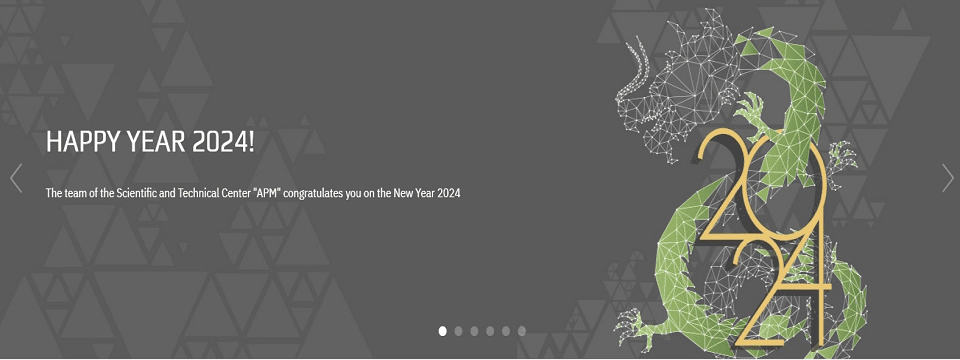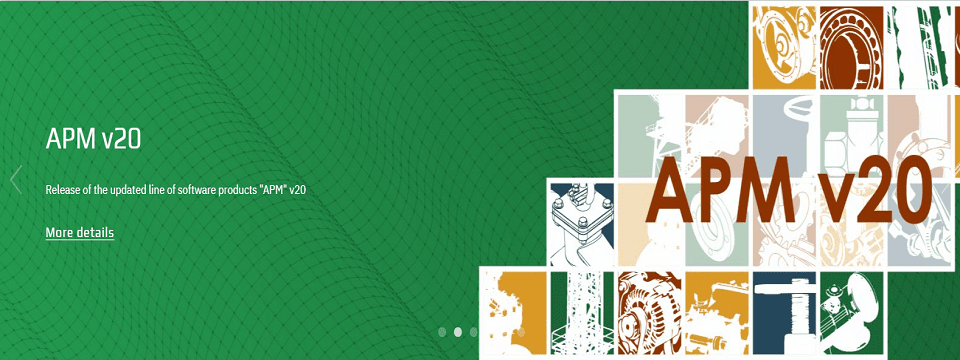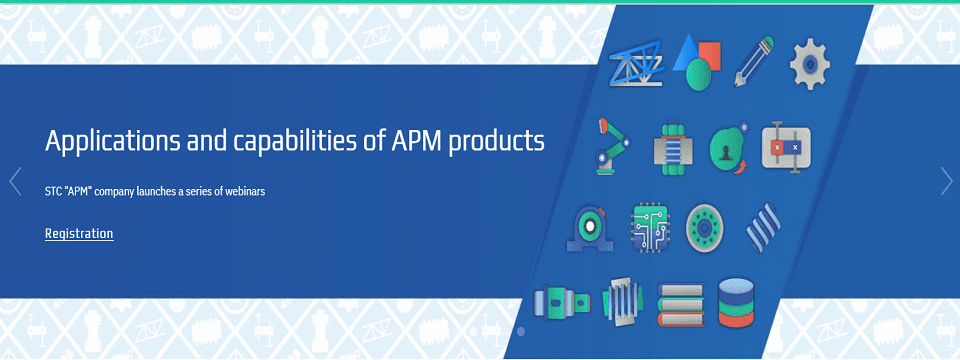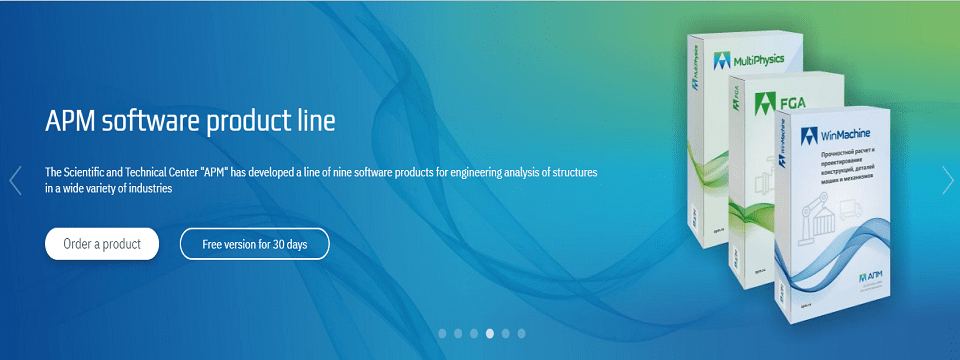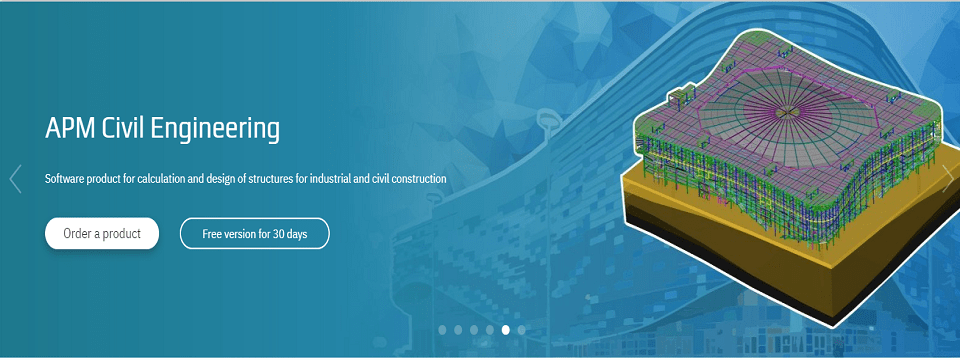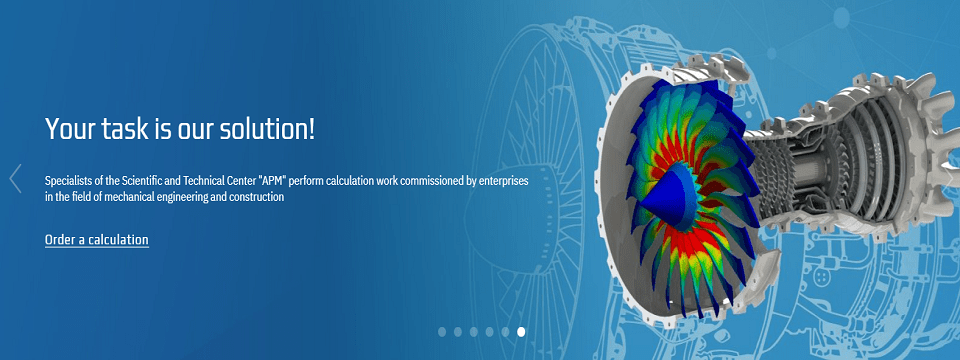APM 20
Dear colleagues and friends!
The team of the Scientific and Technical Center "APM" reports that in the fall of 2023 a new 20th version of our software products - settlement systems of the "APM" line will be released.
The new version of APM software products can suggest the user optimal design solutions using topological and parametric optimization based on the strength analysis, which is an important task in the design of competitive products.
Below we provide a list of new functions and capabilities of the main calculation modules and additional options.
Module for calculating the stress-strain state, stability, natural and forced vibrations of parts and structures using the finite element method
Module for calculating the stress-strain state, stability, natural and forced vibrations of parts and structures using the finite element method
SECTIONS: Interface / Model editing / Saving / Loading
- The mechanism for loading/saving the calculation model has been improved. Significantly (up to 100 times) increased speed when working with HDD drives.
- An option has been added to save calculation parameters, which will allow you to automatically save all settings made by the user when starting a calculation.
- A new form of model storage has been implemented. When saving the model, a folder named “modelname_files” will be created. All settings files, a calculation log and a file with calculation results will be stored in this folder.
- For quick file exchange, the ability to save/load an archive of the calculation model in *.zip format has been implemented.
- The “Select Elements” command has been improved. Now you can also select elements by index.
- Added a dynamic filter for selecting design model elements (nodes, rods, plates, solid FE). To activate it, you need to
press Shift + RMB on a free space in the working field. - The list of filters of the type required to display the numbers of nodes/elements on the model has been expanded. They are convenient to use in conjunction with the “Element Information” dialog and the “Loads” section when viewing results, as well as with the “Select elements by index” command.
- Information about the time it took the calculation algorithm to solve the problem was added to the log file.
- A new operation “Model transfer” has been added (main menu “Tools” - “Additional operations”). It recalculates the position of the structural nodes relative to the base one. In this case, additional loads are recalculated: wind loads, wind pulsations, angular acceleration and speed.
- The functionality of the “Loads” dialog has been expanded:
- when you hover the cursor over a load, a hint with the number of loads is shown;
- added the “Create a copy” button. - The functionality of the “Layers” dialog has been expanded:
- when you hover the cursor over a layer, a hint with the number of elements is shown;
-Added the “Delete layer and all elements” button. - In the “Program Settings” tree, in the “Units of Change” section, the ability to set a consistent system of units (“System Selection”) has been added. When you select a system, all units of measurement change at once.
- A new expanded menu has appeared for working with the “Connections” section
in the “Calculation model” tree. - The functionality of the program has been expanded when importing STL format files. Now you can distribute FEs that fall inside and/or are outside the imported shell into layers.
Module for calculating the stress-strain state, stability, natural and forced vibrations of parts and structures using the finite element method
Module for calculating the stress-strain state, stability, natural and forced vibrations of parts and structures using the finite element method
- SECTIONS: Loads / Impacts / Calculations
- Calculation of inertial unloading. To use it, you need to create an “Inertial unloading” object in the model tree. It indicates the node relative to which it is necessary to balance the system of forces and the directions in which this is necessary. The log displays information about the calculated acceleration for each selected direction and the value of the balancing force. It is taken into account for all load cases as a “fulcrum point”.
- Added a new type of load on the finite element “Temperature load”. Can be specified for bars, plates and volumetric elements.
- Added a new load type “Total moment” in the “Calculation model” tree. The moment can be specified on nodes, rods, plates, volumetric elements and their faces.
- New features within the framework of harmonic analysis (HA) of structures:
- A constant type of damping, independent of frequency, has been introduced;
- Added the ability to control the damping of elastic elements of the “elastic connection” type, as well as “elastic support” and “elastic base”;
- The range of frequency loads for various types of kinematic influences has been expanded.
- Added input of necessary settings;
- Control of visualization of GA results has been moved from the dialog to the “Calculation model” tree. - A new way to specify loads in the “Calculation model” tree. Loads can now be specified in tabular form, which allows the import/export of numerical data via text files.
- In the current version, in the “Calculation model” tree it becomes possible to have several objects of the type “Linear static analysis”, “Nonlinear static analysis”, “Dynamic analysis”. Load cases and combinations of load cases are added to the calculations.
- New features within the framework of topological optimization of structures:
- “irrelevant” items are hidden in the calculation settings tree. Depending on the selected item, the program will show the user only the required set of customizable parameters;
- Added the ability to save stresses during calculations;
- It is possible to start the calculation from the current field of volume fractions (volume fractions are converted into design variables);
- “Restart” of calculation;
- Added “responses-indicators” that allow you to evaluate the characteristics of the model without introducing additional restrictions into the task;
- Accounting for special communication elements has been implemented: “rigid”, “deformable”;
- It is now possible to limit the internal force in any type of elements available for topological optimization;
- Added the ability to take into account “non-strict symmetry”, which will be implemented by the program only in the design space;
- Added “non-strict” (aggressive) compliance with voltage restrictions, which in some cases allows you to obtain a wider range of solutions;
- New technological limitation – “Milling”. At the moment, there is only a restriction on the minimum hole diameter;
- Improved technological limitation “Stamping”. A new, more stable method for taking into account stampability has been built in;
- Ability to save and view what is happening in optimization during the calculation process (external utility, or ParaView).
Module for calculating the stress-strain state, stability, natural and forced vibrations of parts and structures using the finite element method
Module for calculating the stress-strain state, stability, natural and forced vibrations of parts and structures using the finite element method
- SECTION: Post-processing
- A new tool has been added for performing arithmetic operations with calculation results. Operations are performed on the basis of generated result tables (sampling/cutting of calculation results with parameters of interest to the user). These tables can also be visualized as color maps of the results. It is possible to export and import tables of results into text files.
- A new object “Trajectory” has been added to the “Calculation model” tree. It stores an array of nodes selected by the user on the calculation model
and forming a polyline. - A new type of results has been added - “Results by trajectory”. Using a trajectory previously constructed and selected by the user (see paragraph 23), a graph of the type of result of interest can be constructed.
- Linearization of calculation results when using the Path Results tool.
- A new object “Plane” has been added to the “Calculation model” tree. It can be set on the work area by 3 points (nodes), by the edge of an element, or
by a reference point and a normal vector. - New options have been added for viewing results maps: results in the “Section”, as well as at a certain distance from the selected section plane. The initial binding of the section occurs to some plane previously created by the user (see paragraph 26).
- A special “batch” mode for launching calculations (batch) has been implemented. Allows you to perform calculations sequentially for several files. Each file/model can have its own calculation settings and selected load cases for calculation. The user also sets priority settings that will take precedence over those saved in the model (preparing the file manually in a text editor). There is an optional opportunity to verify the calculation results.
Module for calculating the stress-strain state, stability, natural and forced vibrations of parts and structures using the finite element method
Module for calculating the stress-strain state, stability, natural and forced vibrations of parts and structures using the finite element method
- SECTION: "Construction"
- Automation of the calculation method for structures made of cold-formed profiles based on the provisions of EN1993-1-3 has been implemented. The following fundamentally new functionality has been added:
• Regarding the preparation of initial data:
- a tool for creating and editing a model of a thin-walled cross section;
- a tool for creating and working with libraries of thin-walled profiles.
• Regarding the calculation:
- calculation of the geometric characteristics of a thin-walled cross section, including sectorial characteristics;
- calculation of the parameters of the effective cross section based on modeling of cross-section buckling processes;
- calculation of stresses in the cross-section of a thin-walled element;
- comparison of the obtained values with the limit values calculated in accordance with regulatory documents.
• In terms of analysis and post-processing of results:
- a tool for visualizing calculation results in the form of color maps;
- a tool for presenting results in tabular form. - Automation of the processes for calculating the values of shell bed coefficients when performing calculations of buildings and structures on an elastic foundation using user-specified data on the engineering-geological structure of the site has been implemented.
The following fundamentally new functionality has been added:
• Regarding the preparation of initial data:
- a tool for selecting shells in the program tree for which it is necessary to carry out calculations to determine bed coefficients;
- a tool for selecting a method for specifying bed coefficients for shells.
• In terms of calculation:
- a tool for automatic iterative calculation to determine the values of bed coefficients depending on the specified engineering and geological conditions of the construction site;
- a tool for automatically assigning calculated values of bed coefficients to selected shells.
• In terms of analysis and post-processing of the results:
- a tool for visualizing the calculation results in the form of color maps of bed coefficients, pressure under the base of the foundation, foundation settlement.
Geometric modeling module with finite element analysis tools
Geometric modeling module with finite element analysis tools
SECTIONS: Interface / Model editing / Saving / Loading
- Reading of KOMPAS-3D format files (m3d, a3d) has been implemented.
- A preferential transition has been made to creating a computational model through the model tree and the properties panel.
- Saving the “operation tree” when inserting a part into the “Analysis” section.
- New types of virtual connectors have been added - bolt and spring. When installing a bolt, you can set the pretension in several ways.
- Any part in the assembly can now be represented as an absolutely rigid (solid) body. This means that the part in the design diagram will be replaced by a point mass connected to an adjacent part.
- The command for creating a “Custom Coordinate System” (UCS) has been completely redesigned.
- Added normal orientation command for surface models
- Added capabilities for specifying, calculating and analyzing the results of structures made of material such as layered composite (laminate).
- The choice of material from POLYNOMIAL:MDM (ASCON) is enabled.
- The program log window is displayed at the bottom of the screen. For the user, this is an additional opportunity to control the actions of the program.
- A new “Positioning” command has been added, which allows you to move and rotate parts and assemblies in the product model with the ability to copy them.
- Implemented saving of all settings to the registry.
- A new filter has been added - showing the thickness of the plates in color.
- The finite element mesh generation command has been reworked. All settings for solids and surfaces are available at the same time. There is now a choice of partitioning strategy, partitioning with relative steps, as well as an 8-node mesh (“broaching” for simple parts).
- Added FE mesh quality check.
- It is now possible to assign materials to assembly parts by selecting bodies directly in the model tree.
- Added calculation and display of inertial characteristics of parts:
• Volume and Mass - for surface parts;
• Volume, Mass, Center Position, Principal Central Moments of Inertia - for solid parts. - Added functionality necessary to simplify surface details. In the corresponding dialog box, the user selects “simplification mode” and configures the necessary parameters. The main objects of “simplification” will be considered: holes, short edges, small edges, fillets.
Geometric modeling module with finite element analysis tools
Geometric modeling module with finite element analysis tools
- SECTIONS: Loads / Impacts / Calculations
- A new load has been added - “Temperature on the part”. This will allow a static calculation to be carried out, taking into account that the part is heated to a certain temperature without preliminary calculation of thermal conductivity.
- An option has been added to the “Moment” load to set the torque application point.
- New types of calculations have been added:
• nonlinear static;
• nonlinear dynamic with loading in steps;
• harmonic analysis.
Geometric modeling module with finite element analysis tools
Geometric modeling module with finite element analysis tools
- SECTION: Post-processing
- Added results: reactions in the support, forces in the bolt, forces in the spring.
- Implemented output of a color map of contact pressure.
- Output the results to the LCS of the part.
Analysis of liquid and gas flows
Analysis of liquid and gas flows
- Added a new boundary condition (BC) “Heat Source”.
- A new GU “Wall” has been added.
- Improved GU "Turbulence".
- The settings dialog options for vector maps and streamlines have been moved to the APM Structure3D tree.
- Added options for displaying vector maps on a plane.
- A new algorithm for constructing streamlines has been integrated.
- Recording of results for the selected mesh to a text file has been implemented.
- Added calculation of distances to walls along the normal to surfaces.
- Added ke class turbulence models.
- Added wall functions for turbulence models.
- The analysis of flows on deformed meshes has been implemented.
- Reading of results for the analysis of Navier-Stokes currents via a text file has been implemented.

